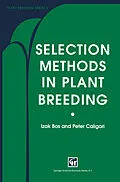Our requirement for plant breeders to be successful has never been greater. However one views the forecasted numbers for future population growth we will need, in the immediate future, to be feeding, clothing and housing many more people than we do, inadequately, at present. Plant breeding represents the most valuable strategy in increasing our productivity in a way that is sustainable and environmentally sensitive. Plant breeding can rightly be considered as one of the oldest multidisciplin ary subjects that is known to humans. It was practised by people who first started to carry out a settled form of agriculture. The art, as it must have been at that stage, was applied without any formal underlying framework, but achieved dramatic results, as witnessed by the forms of cultivated plants we have today. We are now learning how to apply successfully the results of yet imperfect scientific knowledge. This knowledge is, however, rapidly develop ing, particularly in areas of tissue culture, biotechnology and molecular biology. Plant breeding's inherent multifaceted nature means that alongside obvious subject areas like genetics we also need to consider areas such as: statistics, physiology, plant pathology, entomology, biochemistry, weed science, quality, seed characteristics, reproductive biology, trial design, se lection and computing.
Inhalt
Introduction. Population genetic aspects of cross-fertilization. Introduction. Panmixis and diploid chromosome behaviour. Panmixis and autotraploid chromosome behaviour. Inbreeding. Introduction. One locus, two alleles. Two or more loci, each with two alleles. Self-fertilization and autotetraploid chromsome behaviour. Self-fertilization and cross-fertilization. Assortative mating and disassortative mating. Introduction. Repeated backcrossing. Population genetic effects of selection with regared to sex expression. Introduction. The frequency of male sterile plants in the case of complete seed-set of such plants. The frequency of male sterile plants in the case of incomplete seed-set of such plants. Random variation of gene frequencies. Introduction. The effect of the mode of reproduction on the probability of fixation: an example. The effect of the mode of reproduction on the effective number of reproducing plants. Selection. Introduction. The maintenance of genetic variation. Artificial selection for a trait with qualitative variation. Quantitative variation. Introduction. Phenotypic value and genotypic value. Components of the genotypic value. Effects of the mode of reproduction on the expected genotypic value. Introduction. Random mating. Self-fertilization. Inbreeding depression and heterosis. Effects of the mode of reproduction on the genetic variance. Introduction. Random mating. Self-fertilization. Applications of quantitative genetic theory in plant breeding. Prediction of the response to selection. The estimation of quantiative genetic parameters. Breeding value. Prediction of the ranking of crosses. Diallel crosses. Selection for several traits. Introduction. The association between the phenotypic or genotypic values for traits with quantitative variation. Indirect selection. Procedures for estimating the coefficient of phenotypic, environmental or genetic correlation. Index selection and independent-culling-levels selection. Genotypic x environment interaction. Introduction. Single-plant evaluation and elimination of effects of a plant-to-plant trend in soil fertility. Evaluation by means of plots and elimination of effects of a plot-to-plot trend in soil fertility. The detrimental effects of allocompetition on the efficiency of selection. Introduction. Single-plant evaluation and reduction of the detrimental effect of all. Evaluation by means of plots and reduction of the detrimental effect of allocompetition. The optimum number of replications. The size and shape of the test plots. Introduction. How to measure soil heterogeneity. The optimum plot size from an economic point of view. Causes of the low efficiency of selection. The optimum generation to start selection in self-fertilizing crops. Introduction. Reasons to start selection in an early segregating generation. Reasons to start selection in an advanced generation. Experimental designs for plant breeding. References. Index.
